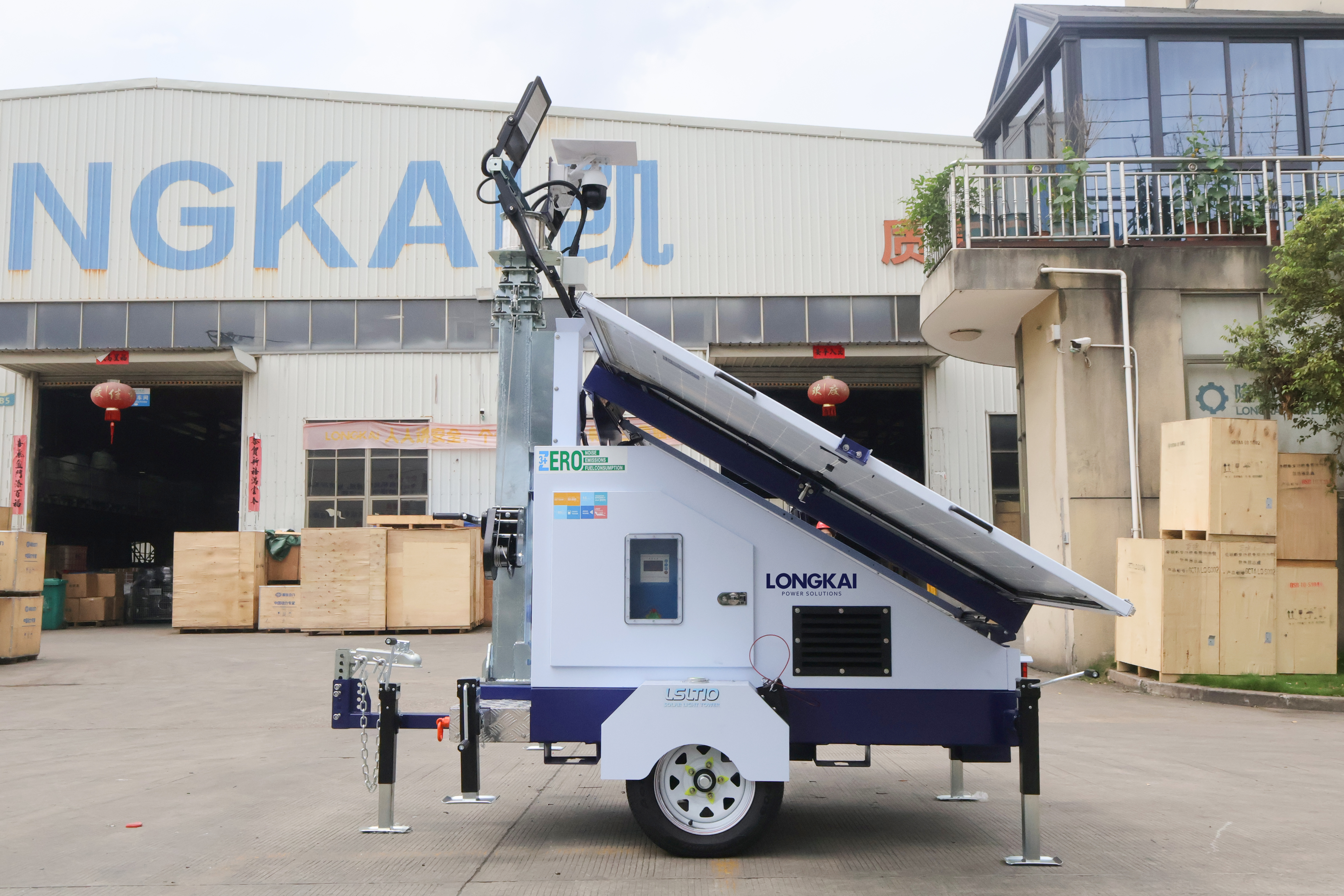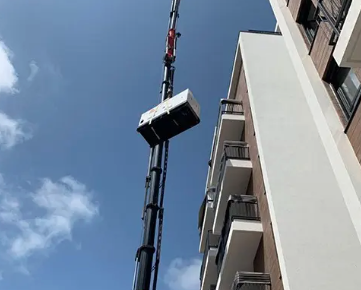Solar lighting towers harness clean solar energy to provide reliable, emission-free illumination ideal for construction sites, events, and emergency use. In this article, we’ll explore how this eco-friendly lighting solution works, its benefits, and why it’s becoming the top choice for those committed to a greener future. Let’s shed some light on solar-powered innovation!
Understanding Solar Lighting Towers
What is a Solar Lighting Tower?
A solar lighting tower is a cutting-edge, eco-friendly lighting solution designed to provide powerful illumination without relying on traditional power sources. These towers are equipped with solar panels, battery storage systems, high-intensity LED lights, and a robust tower structure. The solar panels capture energy from the sun, which is then stored in the battery system to power the LED lights at night. This innovative technology offers a sustainable alternative to conventional diesel-powered lighting towers, which are noisy and produce significant emissions.
Key Features of Solar Lighting Towers
Portability and Ease of Deployment: Solar lighting towers are designed for mobility, often mounted on trailers or skids, making them easy to transport and relocate as needed.
Renewable Energy Source: Solar power is a clean, renewable energy source that reduces reliance on fossil fuels and grid electricity.
Battery Storage and Autonomy: Advanced battery systems ensure that the lights can operate for extended periods, even during cloudy days or at night.
Weather Resistance and Durability: Built with high-quality materials, these towers are designed to withstand harsh weather conditions and long-term use.
Low Maintenance Requirements: With fewer moving parts, solar lighting towers require less maintenance compared to diesel-powered alternatives.
Advantages of Using Solar Lighting Towers as an Eco-Friendly Lighting Solution
Environmental Benefits
Solar lighting towers offer a range of environmental benefits that make them a superior choice for sustainable lighting solutions. One of the most significant advantages is their zero-emission operation. Unlike traditional diesel-powered lighting towers, which emit large amounts of carbon dioxide and other pollutants, solar lighting towers produce no emissions during their operation. This not only reduces the carbon footprint but also minimizes air pollution, making them an ideal choice for environmentally conscious organizations and events.
By harnessing the power of the sun, these towers significantly reduce reliance on fossil fuels, contributing to a greener and more sustainable environment. Additionally, solar lighting towers operate silently, eliminating the noise pollution associated with diesel generators. This makes them particularly suitable for use in sensitive environments such as residential areas, hospitals, and wildlife habitats, where quiet operation is essential.
Economic Benefits
The economic benefits of solar lighting towers are equally compelling. One of the most notable advantages is the significant reduction in operational expenses. Since solar lighting towers do not require fuel, they eliminate the ongoing costs associated with diesel consumption. This results in substantial savings on energy bills, making them a cost-effective solution in the long run. Furthermore, the initial investment in a solar lighting tower, while potentially higher than that of a diesel-powered tower, is offset by the reduced need for maintenance and lower operational costs over time.
Solar lighting towers have fewer moving parts, which means less wear and tear and fewer maintenance requirements. This not only reduces maintenance costs but also extends the lifespan of the equipment. Additionally, many governments and local authorities offer incentives and subsidies for renewable energy projects, making the initial investment in solar lighting towers more affordable. These incentives can significantly reduce the upfront costs and provide a quicker return on investment, making solar lighting towers an economically viable choice for businesses and organizations.
Operational Advantages
Solar lighting towers also offer several operational advantages that make them highly versatile and reliable. One of the key benefits is their independence from the power grid. Unlike traditional lighting solutions that rely on grid electricity, solar lighting towers can operate autonomously, making them ideal for remote locations or areas with unreliable power supplies. This is particularly useful in rural areas, construction sites, and disaster relief operations where access to electricity may be limited. The ability to operate independently ensures that critical operations can continue even during power outages or in off-grid scenarios.
Another significant advantage is the quick and flexible installation of solar lighting towers. These towers are designed for easy deployment and relocation, making them perfect for temporary applications. They can be quickly set up and dismantled, allowing for rapid response in emergency situations and easy adaptation to changing needs. Whether it’s a construction site that requires frequent relocation of lighting or an outdoor event that needs temporary illumination, solar lighting towers provide a highly adaptable solution. Finally, solar lighting towers are highly reliable, especially during emergencies. In the event of natural disasters or power outages, these towers can provide essential lighting, ensuring that critical operations such as rescue missions, medical services, and security measures can continue uninterrupted. Their ability to operate off-grid and independently of external power sources makes them a crucial component in disaster preparedness and response plans.

Components and Technology Behind Solar Lighting Towers
Solar Panels
Types of Solar Panels: Monocrystalline and polycrystalline solar panels are commonly used in solar lighting towers. Monocrystalline panels are known for their higher efficiency and longer lifespan, while polycrystalline panels are more cost-effective.
Efficiency and Energy Capture: Modern solar panels have significantly improved in efficiency, capturing more energy from the sun and converting it into electricity. This ensures that the towers can operate effectively even in areas with less sunlight.
Battery Storage Systems
Types of Batteries: Lithium-ion and lead-acid batteries are the most common types used in solar lighting towers. Lithium-ion batteries offer higher efficiency, longer lifespan, and faster charging times, while lead-acid batteries are more affordable.
Battery Life and Capacity: The capacity and lifespan of the battery system are crucial for ensuring continuous operation. Advanced battery management systems optimize energy use, extending the life of the batteries and ensuring consistent performance.
LED Lighting Technology
Advantages of LEDs: LED lights are highly efficient, consuming less energy while providing bright, consistent illumination. They have a longer lifespan compared to traditional lighting solutions, reducing maintenance costs.
Light Output and Energy Efficiency: High-intensity LED lights provide powerful illumination, making them suitable for a wide range of applications. Their energy efficiency ensures that the towers can operate for extended periods without frequent recharging.
Control Systems and Smart Features
Automatic Sensors: Solar lighting towers are often equipped with automatic sensors, such as motion detection and light sensors, which optimize energy use and ensure the lights are only on when needed.
Remote Monitoring and Control: Advanced models offer remote monitoring and control capabilities, allowing users to manage the lighting from a distance. This feature enhances convenience and ensures optimal performance.
Installation, Maintenance, and Safety Tips for Solar Lighting Towers
Installation Best Practices
Site Selection and Positioning: Choose a location with maximum sunlight exposure and minimal shading. Ensure the tower is positioned securely to prevent tipping.
Securing the Tower: Use anchoring systems to stabilize the tower, especially in areas prone to strong winds or storms.
Routine Maintenance
Cleaning Solar Panels: Regularly clean the solar panels to remove dust and debris, ensuring maximum energy capture.
Battery Checks and Replacements: Periodically check the battery system for any signs of wear and replace batteries as needed.
LED Light and Control System Inspection: Inspect the LED lights and control systems regularly to ensure they are functioning correctly.
Safety Considerations
Electrical Safety Precautions: Follow proper electrical safety protocols to avoid accidents and ensure the safe operation of the tower.
Weather-Related Precautions: Take necessary precautions during extreme weather conditions, such as securing the tower and protecting the solar panels.
Future Trends in Solar Lighting Towers and Eco-Friendly Lighting
Advances in Solar Panel and Battery Technology
Higher Efficiency Panels: Ongoing research and development are leading to higher efficiency solar panels, capturing more energy from the sun and improving overall performance.
Longer-Lasting and Faster-Charging Batteries: Advances in battery technology are resulting in longer-lasting and faster-charging batteries, enhancing the reliability and autonomy of solar lighting towers.
Integration with Smart City and IoT Systems
Remote Monitoring and Management: Solar lighting towers are increasingly being integrated with smart city systems, allowing for remote monitoring and management of lighting networks.
Energy Usage Optimization: Advanced control systems optimize energy usage, ensuring that the towers operate efficiently and reduce overall energy consumption.
Emerging Market Trends and Sustainability Goals
Government Regulations and Incentives: Governments worldwide are implementing regulations and incentives to promote the adoption of renewable energy solutions, making solar lighting towers more accessible and affordable.
Adoption in Developing Regions and Off-Grid Areas: Solar lighting towers are gaining popularity in developing regions and off-grid areas, providing reliable lighting solutions where traditional power infrastructure is lacking.

FAQ
How long do solar lighting towers operate without sunlight?
The run time of a solar lighting tower depends on the battery capacity and the amount of sunlight captured during the day. Most models can operate for several hours to a full night, with some advanced units offering extended autonomy through hybrid solar-diesel systems.
Are solar lighting towers cost-effective compared to traditional lighting?
Yes, solar lighting towers offer significant cost savings over traditional diesel-powered towers. While the initial investment may be higher, the long-term savings on fuel and maintenance make them a cost-effective solution. Additionally, many governments offer incentives and subsidies for renewable energy projects.
Can solar lighting towers be used in all weather conditions?
Solar lighting towers are designed to be weather-resistant and durable, making them suitable for use in various weather conditions. However, extreme weather events may require additional precautions to ensure the safety and stability of the tower.
What maintenance is required for solar lighting towers?
Routine maintenance includes cleaning the solar panels, checking the battery system, and inspecting the LED lights and control systems. These tasks ensure optimal performance and extend the lifespan of the tower.
How quickly can a solar lighting tower be deployed?
Solar lighting towers are designed for quick deployment, with easy setup and relocation capabilities. Depending on the model, they can be deployed and operational within a few hours.
Conclusion
Solar lighting towers represent a significant leap forward in sustainable lighting solutions. By harnessing the power of the sun, these towers offer a reliable, eco-friendly alternative to traditional diesel-powered lighting. The environmental benefits, economic savings, and operational advantages make them an attractive option for a wide range of applications, from construction sites to disaster relief operations. As technology continues to advance and the demand for sustainable solutions grows, solar lighting towers are poised to play a crucial role in the future of lighting. We encourage businesses and communities to consider the benefits of solar lighting towers and take a step towards a greener, more sustainable future.












